Trip Report: Customized Guatemala Birding Loop (5-22 February 2005)
by Kirsten Geertz-Hansen
Participants from Denmark: Kirsten Geertz-Hansen, Erik A. Christiansen, Kirsten Hjortshoej, Bent Hjortshoej, Rita Christensen, Ejgil Skiffard.
Tour leaders in Guatemala: 5-22 Feb. Knut Eisermann and 19-22 Feb. also Claudia Avendaño.
We had found Cayaya Birding on the Internet, and it turned out that we had made a very good choice. We are 6 friends, some of us birders, and all of us nature lovers. We wanted to combine nature observations with the adventure of the Maya culture. Already during the preparation of the trip, Cayaya Birding rendered all kind of service and advice.
5 February 2005
Arrival in Guatemala City from Denmark via Madrid. We were met by Knut, who took us to Hotel Casa Santa Clara, a very nice small hotel in Zone 10.
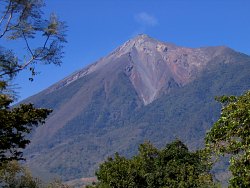
© Knut Eisermann.
6 February 2005
After breakfast our microbus arrived at 8 am. Before leaving, we just spotted a few birds opposite our hotel, like Gray Silky Flycatcher, Golden-fronted Woodpecker, and then of course the Great-tailed Grackles, which are everywhere with all their funny sounds. We went to Parque Central where people were coming in for the Sunday market. We enjoyed seeing the beautiful textiles the women exposed, and we saw the memorial for all the people who had been killed just some few years ago. Coming from a peaceful country like Denmark, it is hard to believe all the cruelties the people in Guatemala had to go through.
We left the city and passed the fantastic landscapes with several volcanos, of which Fuego had eruptions every now and then. Whereas standing in the open and looking at this volcano, several swifts were in the air. We had White-collared Swift, Black Swift as well as Vaux’s Swift. From the bus we also frequently saw the common Black and Turkey Vultures in the air, and once we saw a Crested Caracara passing by.
After a couple of hours we reached Los Tarrales Reserve on the south side of the Atitlan Volcano. The farm has a delightful situation in the landscape, surrounded by forests and mountains. 73 families are living in cottages around the centre, working in the coffee plantation and with ornamental plants and some of them are educated to be guides for tourists or birders. It was a small society apart, which seemed to radiate harmony and kindness. The forest and the plantations were full of birds. At the entrance we first saw the fine big White-throated Magpie Jay. Flocks of Pacific Parakeets and Orange-fronted Parakeets passed between the trees, Clay-coloured Robin searched the garden floor. We went a little around and had a stop at a very beautiful orange-blooming tree. This tree attracted many birds, e.g. Red-legged Honey Creeper, Melodious Blackbird, Orchard Oriole, Baltimore Oriole and Green-breasted Mango. In the next tree we observed a Gray Hawk. During some few hours we had observed 35 species and without mentioning all, we could point out the Masked Titara, Squirrel Cuckoo, Long-billed Starthroat, Spot-breasted Oriole, Altmira Oriole, Blue-Crowned Motmot, Tropical Kingbird and Collared Aracari. We were also informed about the beautiful plants and flowers and about this cultivation, sale and export.
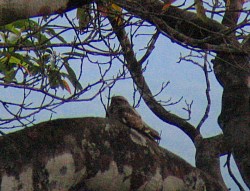
7 February 2005
Coffee at 5.30 and off we went in 2 cars up the mountain from 760 m to 1400 m altitude. The sunrise was unforgettable with the orange-turquoise sky as back cloth for the smoking volcano, and the trees teeming with small birds, especially a great number of Red-legged Honeycreepers. Knut knew all the calls and could tell us when the Highland Guan and many others were calling. We walked slowly downhill, trying to see all the lively small birds like Wilsons Warbler, Tennessee Warbler, Yellow-throated Vireo, White-winged Tanager, Northern Bentbill, Northern Beardless Tyrannulet and so on. Along the trail an Emerald Toucanet was moving in the foliage. At about 11 am a truck picked us up to go back to the house for lunch. In the afternoon, the 21-year old guide Josué from the Los Tarrales Reserve made us a fine presentation of the coffee production, although this is slowed down at the moment.
8 February 2005
We had another early morning walk, observing more birds. We enjoyed the beauty and great variety of the forest. From this walk, we would point out the Long-tailed Manakin, Rufous-browed Peppershrike, Rose-breasted Grosbeak, Blue-Grey Gnatcatcher, Rose-throated Becard, Barred Antshrike, and many hummingbirds: Cinnamon , Berrilene , Ruby-Throated and Blue-tailed Hummingbird. When we came back and were seated for lunch, a Bat Falcon also took a seat, although outside on the antenna, absolutely photogenic. It was time to leave. Our total list for Los Tarrales (birds seen and heard) amounted to 105 species!
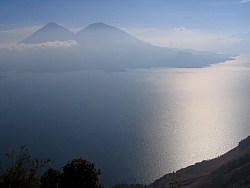
© Knut Eisermann.
The Atitlan Lake was our next destination. From a high view-point we had the first sight of this famous lake in sunshine. At this level a Red-tailed Hawk as well a White-breasted Hawk were passing by. Then we went down to Panajachel to stay at "Cacique Inn" for the next 3 nights. From the balcony at the rooms we had good opportunity to watch birds such as Social Flycatcher, Gray Silky Flycatcher, Lesser Goldfinch, Black-headed Siskin, Azure-Crowned Hummingbird, and Tropical Mockingbird.
9 February 2005
Knut had arranged for a small boat for us to go across Lake Atitlan to Santiago. From the boat we saw Lesser Scaup, Ruddy Duck, Least Grebe, Great Egret, Green Heron, American Coot, Spotted Sandpiper and Laughing Gull. The great attraction in the town is the visit to the Tzutuhil Indian house, where Maximon is worshipped. A very exotic ceremony to see for us. Although many tourists come to this town, it seemed to be quite genuine how they stick to their old traditions and clothing.
In the afternoon, we had a walk to the nature reserve in the hills above the hotel. Here we saw our first Spider Monkeys, and some of the birds were White-eared Hummingbird, Magnificent Hummingbird, Acorn Woodpecker, Chestnut-browed Peppershrike and Northern Flicker.
10 February 2005
This day was reserved for Chichicastenango, as we had all wanted to see this great and colorful market. It gave us a wonderful impression of the local people, their handicraft and products, as well as the surviving Indian spirituality. But birding was not on the program that day.
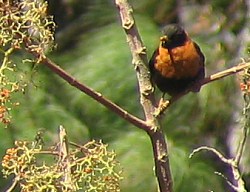
© Knut Eisermann.
11 February 2005
We headed back towards Guatemala City, with several stops. We went to see an exhibition of orchids in Antiqua, shown just that day, after which we went to a pine and oak forest in the highland with interesting birds like Pink-headed Warbler, Painted Redstart and Slate-throated Redstart. Ejgil, who is especially interested in Fuchsia, found a small wild Fuchsia bush with flowers. The next stop was at the ruins of Iximché, the main site for the Cakchiquel Maya people from about 1470. Around the site we saw various birds, and enjoyed a group of Rufous-collared Robins in some rufous colored bushes. In an old tree we found hundreds of holes in which Acorn Woodpeckers had made themselves a large store of acorns. In the evening, in Guatemala City, we met Claudia for the first time and had a nice dinner together entertained by several groups of musicians.
12 February 2005
We left the hotel very early to catch a plane to St. Elena airport in Petén. From the airport, we went to the nearby town of Flores to have breakfast and look at the picturesque town as well as the surrounding lake. Both Ringed and Belted Kingfisher were perching on the wires, and on the lake a Pied-billed Grebe was swimming. The microbus continued to Yaxhá, a couple of hours from Flores. We were lodged in "El Sombrero", a wonderful place at the Yaxhá Lagoon. Yaxhá is an archaeological Maya site less known than Tikal, and we did not see many tourists. The lodge has been used by archaeologists during many years, and consists of some thatched cottages in the forest close to the lake. Outside our cottage we had a pair of White-collared Seedeaters, and Rufous-tailed Hummingbird as well as Wedge-tailed Sabrewing. A pick-up was bringing us up to the part of the forest with the excavated pyramids. The Mexican Howler Monkeys are very active, several groups are giving deafening concerts. We mount the highest pyramid with a breathtaking view over the lagoon and to other pyramids. Now the howlers are below us. The most impressive sight is a King Vulture, really majestic as it sails across the blue sky in dazzling sunlight. Down again we observe a Pale-billed Woodpecker entering a nest hole.
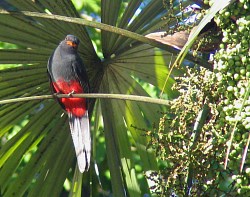
© Knut Eisermann.
13 February 2005
At early dawn, we went out by boat to approach the pyramids from another angle. When landing, we hear that we are laughed at. It is the Laughing Falcon in a very cheerful mood. We also hear a froglike voice, which turned out to come from the Keel-billed Toucan, and what a bird to look at! Many steps brought us up to the site, and we had our breakfast on the pyramid top to enjoy the morning light and all the birds. The parrots were leaving the treetops, the Mealy Parrots are especially noisy. At the foot of the pyramid, Slaty-tailed and Black-headed Trogons got their breakfast too, they fed on fruit of palm trees, and posed willingly before our cameras.
In the afternoon, we sailed on the lake again. On the shores we saw Killdeers, Greater Yellowlegs, Spotted Sandpiper and Least Sandpiper. Also Neotropic Cormorant, Green Heron, Great Blue Heron, Great Egret, Snowy Egret, Little Blue Heron and Tricolored Heron were represented. After sunset, we tried to find crocodiles by torch light. The crocodiles seemed to be few and difficult to find, and in spite of the crocodile skulls at the lodge and the horror stories, we did not feel that we were in any danger.

© Knut Eisermann.
14 February 2005
Another morning enjoying our breakfast on the pyramid. The owner of the lodge, Gabriella, met us there and explained to us about the excavations which she has followed closely. We could only try to imagine how life has been here many centuries ago. Between Yaxhá and Tikal, 28 sites have been found. Around us are many overgrown cone-shaped hills: Mayan buildings which have never been excavated. The forest has taken them back. We were standing in a huge forested area, almost unpopulated by humans. No wonder there are so many birds.
In the afternoon we drove to Tikal. At the entrance we were met by a Great Curassow, which was making quite a display at the roadside. We were put up at the Jaguar Inn, in front of which we were also welcomed by an Ocellated Turkey. These turkeys are nearly tame in Tikal, although they are actually wild birds. As hunting is forbidden in the National Park, some birds and also mammals can be observed quite closely, and we saw also Coaties and Agouties several times. Some of the group had energy to take an evening walk, whereas some of us were relaxing.
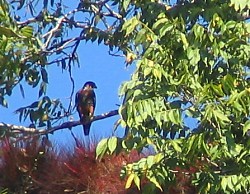
© Knut Eisermann.
15 February 2005
We left our lodge in darkness, and as soon as we could see dimly, Knut discovered a Northern Tamandua (anteater) in a tree. This was really great to see, especially when it slided forward on its belly down the trunk. On the ground, Wood Thrushes were running, and suddenly the forest opened up. In the first daylight we had Temple I before us, and when approaching we then saw the whole group of palaces and pyramids. It impressed us strongly. Knut told us the facts and the theories, although the birds tried to disturb. A tall tree is full of big hanging nests made by the Montezuma Oropendula, and they were also around, clucking and gurgling and rolling forwards with the yellow tail in the air. Also various parrots were in the trees, e.g. Red-lored Parrots and Aztec Parakeet. Many Collared Aracaris flocked together. Also White-crowned , White-fronted , Brown-hooded Parrot came on the list. At one of the temples, the rare Orange-breasted Falcon was sitting in a tree. At an open space in the forest we further saw such beautiful birds as Red-capped Manakin and Royal Flycatcher. Ovenbird and Kentucky Warbler were seen very well. A pair of Chestnut-colored Woodpeckers chased loudly around, very fine to see with their raised yellow crests.
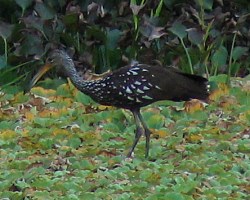
© Knut Eisermann.
In the afternoon we visited the museum and ended at the ponds nearby. Rita was not delighted with the two crocodiles floating in the surface. On the other hand, the birdlife was really fascinating. On the floating vegetation we saw the Northern Jacana with quite different looking immatures, Limkin, Purple Gallinule, Gray-necked Wood-Rail came all quite so close that we could see every feather and admire their fine colors. Northern Water Thrush was also present, Keel-billed Toucan and Montezuma Oropendula visited the trees at the pond. A pair of Great Currasows turned up under some trees and just before darkness, a great number of Black Vultures assembled in a big tree near the lodge.
16 February 2005
The morning was misty and the birds appeared softly in the grey. In this light we saw a Plain Chachalaca, a Blue-crowned Motmot and Black-headed Trogon. Great Tinamou was heard. We climbed Temple IV and the Brown Jays looked interested at our cinnamon bread. Out in the haze were two Orange-breasted Falcons sitting. Knut had brought a big microphone and recorded their calls. In the forest we spotted various woodcreepers and tyrannts, I must refer to the list, there were just so many. Later the sun came through and a Gray Fox passed by at the edge of the forest. Back at the lodge there was a wonderful Violacious Trogon on a branch just above us. It looked curiously at us, but remained sitting, just turning round now and then to show the yellow front side as well as the shiny back. We went out again for a late walk, where we found a Bat Falcon at Tempe VI, and obviously it was nesting inside the temple wall.
17 February 2005
This morning we were walking outside the park, starting also with some mist and a great chorus of Plain Chachalacas. There was a Thicket Tinamou in the bushes. During our walk we had Buff-bellied Hummingbird, Purple-crowned Fairy, Chestnut-sided Warbler, Yellow-olive Flycatcher, Barred Antshrike, White-winged Becard, Sulphur-bellied Flycatcher, White-eyed and Mangrove Vireo and a lot of other small birds. The area we visited had some new trails, we could follow, and along the trail many trees had signboards with name and information. It was very interesting. This part of the forest was more wet, swampy and jungle-like. A platform was placed in a tall tree, and we could enter the platform by climbing several ladders and get a fine view to the remote pyramids. Closer to us was a beautiful Roadside Hawk perching in a treetop. Keel-billed Toucan was also seen in the canopy. We were very amused when we came across some Spider Monkeys. One of them was very aggressive. It did not accept our presence, and it was shaking the branches, screaming, trying to pee on us, and at last it put out its tongue at us. We came back for lunch, the last bird before we left Tikal was a Groove-billed Ani sitting on the grass when we waited for our microbus to take us to the airport.
Back in Guatemala City we went directly out to Antiqua. We arrived late and came to our home for the next two days, Hotel San Jorge, a very charming place with rooms around a patio with many flowers and a fountain. We tried some local dishes at a restaurant and learnt "Sin comer y beber no hay placer".
18 February 2005
Breakfast in the patio where a flock of Cedar Waxwing came by. Then by car up in the Cloud Forest above Antiqua at 2500 m altitude. There was a wonderful view to the volcanoes, and we went into a forest with birds of the highland. Very beautiful was a pair of Blue-hooded Euphonia, also Hooded Grosbeak, Black-and-White Warbler, Red-faced Warbler, Yellow-bellied Sapsucker, Collared Trogon, Rufous-browed and Spotted Woodcreepers, Western Tanager, Great Peewee, Bushtit, to mention some. We saw some Black-capped Swallows with nesting holes.
In the afternoon we looked at the beautiful town of Antiqua and at their handicraft markets. From the church came a procession with school girls. In the everning Claudia arrived and we had a very good dinner together.
19 February 2005
Two birthdays on the same day. That was celebrated in the Danish way. We had a nice morning in the patio, and left when everybody had finished their business with bank, post office etc. Now Claudia was with us too. A little outside Antiqua we visited a Macadamia eco-plantation. We did not know these delicious nuts, which they sell with and without chocolate coating. In the plantation, there were some Bushy-crested Jays. We were heading for the Pacific Coast, and came from the highland to a savannah-like landscape. Many Black and Turkey Vultures as well as Barn Swallows along the road. After Puerto San José the roads are narrower, and we have to pass a river on a ferry. At long last we reached our hotel - it was very hot. We got installed in various cottages, and the Pacific Ocean was just outside with big waves, and Brown Pelicans flying just above the waves. A few Magnificent Frigatebirds and a Brown Booby were observed.
We had a walk in the hinterland - a small dirty dry forest with much scrap and 1000 moscitoes, but still it was possible to find new birds, such as Turquoise-browed Motmot, Inca Dove and Stripe-headed Sparrow. A Ferruginous Pygmy Owl was whistling nearby. Also Rose-throated Becard was seen.
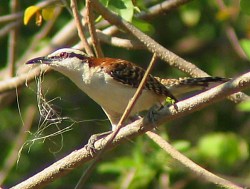
© Knut Eisermann.
20 February 2005
We got up early (4.30 am) and walked down to "Montericco Harbour" where a boat was waiting for us to take us on a wonderful trip to a lagoon. In the early dawn many Lesser Nighthawks, Black-capped Night-Herons and Boat-billed Herons were flying across the water. It was clearing up and we saw hundreds of White Pelicans, many Caspian Terns and Royal Terns, several flocks of Black Skimmer, Gull-billed Tern was also seen, Osprey, about 10 Anhingas, 7-8 Wood Storks, Least Bittern, all the Herons and Egrets, including Bare-throated Tiger Heron, Red-winged Blackbirds in swarms. Blue-winged Teal, Scissor-tailed Flycatcher are also worth to mention, and the Lesser Yellow-headed Vulture. The most impressive was the concentration of white egrets in the bottom of the Lagoon. There were thousands of Great and Snowy Egrets standing "shoulder to shoulder". Unforgettable.
In the afternoon we passed a pair of Rufous-naped Wrens constructing a nest, when we were on our way to the conservation centre for crocodiles, iguanas and sea turtles. At sunset time, we participated in the turtle race. Turtle babies, hatched under the protection of the centre, were set out, everybody payed for a small turtle. The first little turtle reaching the sea has won, and the sponsor got a dinner. Many people came and thereby supported the project. The turtles get a chance to survive. The local people used to eat the eggs, now they deliver 20% to the centre.
21 Februry 2005
Again a boat trip from early morning, but this time in the mangrove part with narrow passages with the foliage closing above our heads and the trees standing on stilts. Many of the birds were the same as the day before, but not in the same numbers. However, this mangrove was more suitable for the kingfishers, and we saw Belted, Ringed, Green and Pygmy Kingfisher. A Black Hawk was also sitting in the mangrove. We came to a small island, where a family was living and producing salt, which they extract from the earth when the water disappears. We see their production method, which is primitive, and we wonder how they can live on that. They get 25 tons of salt in a year, and of course they can also catch fish in the waters. On the island, we see a Lesser Nighthawk sitting in a tree, and a flock of Least Sandpipers is foraging in the bay.
After lunch, we drove back to Guatemala City. This was our last day in Guatemala, and we had a wonderful Farewell Dinner in the City.
22 February 2005
Bent and Kirsten H. flew to Mexico, whereas Erik, Kirsten G., Ejgil and Rita were picked up by a car from El Salvador, where they spent some days. The Guatemala tour had come to an end. Thanks to our wonderful guides Knut and Claudia, it has been a great success. No bird ever escaped without being identified by them. At the beginning of the tour, we asked Knut how many birds he expected us to find. He said up to 300 if we were very lucky. So we have been very lucky, as the list of birds - seen and heard - was well above this magic figure. We thank you not only for all the birds, but also for your pleasant company. It has been a very eventful and happy tour!
Kirsten Geertz-Hansen, Farum, Denmark
List of bird species which were observed during this tour.
Species nomenclature according to AOU (1998) and supplements.
- Great Tinamou Tinamus major
- Thicket Tinamou Crypturellus cinnamomeus
- Blue-winged Teal Anas discors
- Lesser Scaup Aythya affinis
- Ruddy Duck Oxyura jamaicensis
- Plain Chachalaca Ortalis vetula
- White-bellied Chachalaca Ortalis leucogastra
- Crested Guan Penelope purpurascens
- Highland Guan Penelopina nigra
- Great Curassow Crax rubra
- Ocellated Turkey Meleagris ocellata
- Spotted Wood-Quail Odontophorus guttatus
- Least Grebe Tachybaptus dominicus
- Pied-billed Grebe Podilymbus podiceps
- Brown Booby Sula leucogaster
- American White Pelican Pelecanus erythrorhynchos
- Brown Pelican Pelecanus occidentalis
- Neotropic Cormorant Phalacrocorax brasilianus
- Anhinga Anhinga anhinga
- Magnificent Frigatebird Fregata magnificens
- Least Bittern Ixobrychus exilis
- Bare-throated Tiger-Heron Tigrisoma mexicanum
- Great Blue Heron Ardea herodias
- Great Egret Ardea alba
- Snowy Egret Egretta thula
- Little Blue Heron Egretta caerulea
- Tricolored Heron Egretta tricolor
- Cattle Egret Bubulcus ibis
- Green Heron Butorides virescens
- Black-crowned Night-Heron Nycticorax nycticorax
- Boat-billed Heron Cochlearius cochlearius
- White Ibis Eudocimus albus
- Wood Stork Mycteria americana
- Black Vulture Coragyps atratus
- Turkey Vulture Cathartes aura
- Lesser Yellow-headed Vulture Cathartes burrovianus
- King Vulture Sarcoramphus papa
- Osprey Pandion haliaetus
- White-tailed Kite Elanus leucurus
- Sharp-shinned Hawk Accipiter striatus
- Cooper's Hawk Accipiter cooperii
- Gray Hawk Asturina nitida
- Common Black-Hawk Buteogallus anthracinus
- Roadside Hawk Buteo magnirostris
- Red-tailed Hawk Buteo jamaicensis
- Barred Forest-Falcon Micrastur ruficollis
- Collared Forest-Falcon Micrastur semitorquatus
- Crested Caracara Caracara cheriway
- Laughing Falcon Herpetotheres cachinnans
- Bat Falcon Falco rufigularis
- Orange-breasted Falcon Falco deiroleucus
- Ruddy Crake Laterallus ruber
- Gray-necked Wood-Rail Aramides cajanea
- Purple Gallinule Porphyrio martinica
- Common Moorhen Gallinula chloropus
- American Coot Fulica americana
- Limpkin Aramus guarauna
- Killdeer Charadrius vociferus
- Black-necked Stilt Himantopus mexicanus
- Northern Jacana Jacana spinosa
- Greater Yellowlegs Tringa melanoleuca
- Spotted Sandpiper Actitis macularius
- Least Sandpiper Calidris minutilla
- Laughing Gull Larus atricilla
- Gull-billed Tern Sterna nilotica
- Caspian Tern Sterna caspia
- Royal Tern Sterna maxima
- Sandwich Tern Sterna sandvicensis
- Black Skimmer Rynchops niger
- Rock Pigeon Columba livia
- Scaled Pigeon Patagioenas speciosa
- Red-billed Pigeon Patagioenas flavirostris
- Band-tailed Pigeon Patagioenas fasciata
- Short-billed Pigeon Patagioenas nigrirostris
- White-winged Dove Zenaida asiatica
- Inca Dove Columbina inca
- Ruddy Ground-Dove Columbina talpacoti
- Blue Ground-Dove Claravis pretiosa
- White-tipped Dove Leptotila verreauxi
- Ruddy Quail-Dove Geotrygon montana
- Pacific Parakeet Aratinga strenua
- Olive-throated Parakeet Aratinga nana
- Orange-fronted Parakeet Aratinga canicularis
- Orange-chinned Parakeet Brotogeris jugularis
- Brown-hooded Parrot Pionopsitta haematotis
- White-crowned Parrot Pionus senilis
- White-fronted Parrot Amazona albifrons
- Red-lored Parrot Amazona autumnalis
- Mealy Parrot Amazona farinosa
- Squirrel Cuckoo Piaya cayana
- Pheasant Cuckoo Dromococcyx phasianellus
- Groove-billed Ani Crotophaga sulcirostris
- Vermiculated Screech-Owl Megascops guatemalae
- Ferruginous Pygmy-Owl Glaucidium brasilianum
- Mottled Owl Ciccaba virgata
- Lesser Nighthawk Chordeiles acutipennis
- Common Pauraque Nyctidromus albicollis
- Whip-poor-will Caprimulgus vociferus
- Black Swift Cypseloides niger
- White-collared Swift Streptoprocne zonaris
- Vaux's Swift Chaetura vauxi
- Long-billed Hermit Phaethornis longirostris
- Stripe-throated Hermit Phaethornis striigularis
- Scaly-breasted Hummingbird Phaeochroa cuvierii
- Wedge-tailed Sabrewing Campylopterus curvipennis
- Violet Sabrewing Campylopterus hemileucurus
- Green-breasted Mango Anthracothorax prevostii
- White-eared Hummingbird Hylocharis leucotis
- White-bellied Emerald Amazilia candida
- Azure-crowned Hummingbird Amazilia cyanocephala
- Berylline Hummingbird Amazilia beryllina
- Blue-tailed Hummingbird Amazilia cyanura
- Rufous-tailed Hummingbird Amazilia tzacatl
- Buff-bellied Hummingbird Amazilia yucatanensis
- Cinnamon Hummingbird Amazilia rutila
- Magnificent Hummingbird Eugenes fulgens
- Purple-crowned Fairy Heliothryx barroti
- Plain-capped Starthroat Heliomaster constantii
- Ruby-throated Hummingbird Archilochus colubris
- Black-headed Trogon Trogon melanocephalus
- Violaceous Trogon Trogon violaceus
- Mountain Trogon Trogon mexicanus
- Collared Trogon Trogon collaris
- Slaty-tailed Trogon Trogon massena
- Tody Motmot Hylomanes momotula
- Blue-crowned Motmot Momotus momota
- Turquoise-browed Motmot Eumomota superciliosa
- Ringed Kingfisher Ceryle torquatus
- Belted Kingfisher Ceryle alcyon
- Amazon Kingfisher Chloroceryle amazona
- Green Kingfisher Chloroceryle americana
- American Pygmy Kingfisher Chloroceryle aenea
- Rufous-tailed Jacamar Galbula ruficauda
- Emerald Toucanet Aulacorhynchus prasinus
- Collared Aracari Pteroglossus torquatus
- Keel-billed Toucan Ramphastos sulfuratus
- Olivaceous Piculet Picumnus olivaceus
- Acorn Woodpecker Melanerpes formicivorus
- Golden-fronted Woodpecker Melanerpes aurifrons
- Yellow-bellied Sapsucker Sphyrapicus varius
- Hairy Woodpecker Picoides villosus
- Golden-olive Woodpecker Piculus rubiginosus
- Northern Flicker Colaptes auratus
- Chestnut-colored Woodpecker Celeus castaneus
- Lineated Woodpecker Dryocopus lineatus
- Pale-billed Woodpecker Campephilus guatemalensis
- Plain Xenops Xenops minutus
- Scaly-throated Leaftosser Sclerurus guatemalensis
- Tawny-winged Woodcreeper Dendrocincla anabatina
- Olivaceous Woodcreeper Sittasomus griseicapillus
- Northern Barred-Woodcreeper Dendrocolaptes sanctithomae
- Ivory-billed Woodcreeper Xiphorhynchus flavigaster
- Spot-crowned Woodcreeper Lepidocolaptes affinis
- Barred Antshrike Thamnophilus doliatus
- Black-faced Antthrush Formicarius analis
- Yellow-bellied Tyrannulet Ornithion semiflavum
- Northern Beardless-Tyrannulet Camptostoma imberbe
- Greenish Elaenia Myiopagis viridicata
- Yellow-bellied Elaenia Elaenia flavogaster
- Ochre-bellied Flycatcher Mionectes oleagineus
- Sepia-capped Flycatcher Leptopogon amaurocephalus
- Paltry Tyrannulet Zimmerius vilissimus
- Northern Bentbill Oncostoma cinereigulare
- Common Tody-Flycatcher Todirostrum cinereum
- Eye-ringed Flatbill Rhynchocyclus brevirostris
- Yellow-olive Flycatcher Tolmomyias sulphurescens
- Stub-tailed Spadebill Platyrinchus cancrominus
- Royal Flycatcher Onychorhynchus coronatus
- Ruddy-tailed Flycatcher Terenotriccus erythrurus
- Sulphur-rumped Flycatcher Myiobius sulphureipygius
- Tufted Flycatcher Mitrephanes phaeocercus
- Greater Pewee Contopus pertinax
- Tropical Pewee Contopus cinereus
- Yellow-bellied Flycatcher Empidonax flaviventris
- Willow Flycatcher Empidonax traillii
- Least Flycatcher Empidonax minimus
- Hammond’s Flycatcher Empidonax hammondii
- Bright-rumped Attila Attila spadiceus
- Rufous Mourner Rhytipterna holerythra
- Dusky-capped Flycatcher Myiarchus tuberculifer
- Great Crested Flycatcher Myiarchus crinitus
- Brown-crested Flycatcher Myiarchus tyrannulus
- Great Kiskadee Pitangus sulphuratus
- Boat-billed Flycatcher Megarynchus pitangua
- Social Flycatcher Myiozetetes similis
- Tropical Kingbird Tyrannus melancholicus
- Couch’s Kingbird Tyrannus couchii
- Scissor-tailed Flycatcher Tyrannus forficatus
- Thrush-like Schiffornis Schiffornis turdina
- Rufous Piha Lipaugus unirufus
- White-winged Becard Pachyramphus polychopterus
- Rose-throated Becard Pachyramphus aglaiae
- Masked Tityra Tityra semifasciata
- Black-crowned Tityra Tityra inquisitor
- Long-tailed Manakin Chiroxiphia linearis
- Red-capped Manakin Pipra mentalis
- White-eyed Vireo Vireo griseus
- Mangrove Vireo Vireo pallens
- Yellow-throated Vireo Vireo flavifrons
- Blue-headed Vireo Vireo solitarius
- Hutton's Vireo Vireo huttoni
- Warbling Vireo Vireo gilvus
- Tawny-crowned Greenlet Hylophilus ochraceiceps
- Lesser Greenlet Hylophilus decurtatus
- Green Shrike-Vireo Vireolanius pulchellus
- Rufous-browed Peppershrike Cyclarhis gujanensis
- White-throated Magpie-Jay Calocitta formosa
- Brown Jay Cyanocorax morio
- Bushy-crested Jay Cyanocorax melanocyaneus
- Purple Martin Progne subis
- Gray-breasted Martin Progne chalybea
- Mangrove Swallow Tachycineta albilinea
- Black-capped Swallow Notiochelidon pileata
- Northern Rough-winged Swallow Stelgidopteryx serripennis
- Cliff Swallow Petrochelidon pyrrhonota
- Cave Swallow Petrochelidon fulva
- Barn Swallow Hirundo rustica
- Bushtit Psaltriparus minimus
- Brown Creeper Certhia americana
- Band-backed Wren Campylorhynchus zonatus
- Rufous-naped Wren Campylorhynchus rufinucha
- Spot-breasted Wren Thryothorus maculipectus
- Plain Wren Thryothorus modestus
- House Wren Troglodytes aedon
- Rufous-browed Wren Troglodytes rufociliatus
- White-bellied Wren Uropsila leucogastra
- White-breasted Wood-Wren Henicorhina leucosticta
- Gray-breasted Wood-Wren Henicorhina leucophrys
- Long-billed Gnatwren Ramphocaenus melanurus
- Blue-gray Gnatcatcher Polioptila caerulea
- Tropical Gnatcatcher Polioptila plumbea
- Brown-backed Solitaire Myadestes occidentalis
- Orange-billed Nightingale-Thrush Catharus aurantiirostris
- Swainson's Thrush Catharus ustulatus
- Hermit Thrush Catharus guttatus
- Wood Thrush Hylocichla mustelina
- Clay-colored Robin Turdus grayi
- White-throated Robin Turdus assimilis
- Rufous-collared Robin Turdus rufitorques
- Gray Catbird Dumetella carolinensis
- Tropical Mockingbird Mimus gilvus
- Cedar Waxwing Bombycilla cedrorum
- Gray Silky-flycatcher Ptilogonys cinereus
- Olive Warbler Peucedramus taeniatus
- Tennessee Warbler Vermivora peregrina
- Crescent-chested Warbler Parula superciliosa
- Yellow Warbler Dendroica petechia
- Chestnut-sided Warbler Dendroica pensylvanica
- Magnolia Warbler Dendroica magnolia
- Yellow-rumped Warbler Dendroica coronata
- Black-throated Green Warbler Dendroica virens
- Townsend's Warbler Dendroica townsendi
- Hermit Warbler Dendroica occidentalis
- Black-and-white Warbler Mniotilta varia
- American Redstart Setophaga ruticilla
- Worm-eating Warbler Helmitheros vermivorum
- Ovenbird Seiurus aurocapilla
- Northern Waterthrush Seiurus noveboracensis
- Louisiana Waterthrush Seiurus motacilla
- Kentucky Warbler Oporornis formosus
- Common Yellowthroat Geothlypis trichas
- Wilson's Warbler Wilsonia pusilla
- Red-faced Warbler Cardellina rubrifrons
- Pink-headed Warbler Ergaticus versicolor
- Painted Redstart Myioborus pictus
- Slate-throated Redstart Myioborus miniatus
- Golden-crowned Warbler Basileuterus culicivorus
- Rufous-capped Warbler Basileuterus rufifrons
- Golden-browed Warbler Basileuterus belli
- Bananaquit Coereba flaveola
- Black-throated Shrike-Tanager Lanio aurantius
- Red-crowned Ant-Tanager Habia rubica
- Red-throated Ant-Tanager Habia fuscicauda
- Summer Tanager Piranga rubra
- Western Tanager Piranga ludoviciana
- White-winged Tanager Piranga leucoptera
- Blue-gray Tanager Thraupis episcopus
- Yellow-winged Tanager Thraupis abbas
- Red-legged Honeycreeper Cyanerpes cyaneus
- Blue-black Grassquit Volatinia jacarina
- White-collared Seedeater Sporophila torqueola
- Chestnut-capped Brush-Finch Buarremon brunneinucha
- Green-backed Sparrow Arremonops chloronotus
- White-eared Ground-Sparrow Melozone leucotis
- Rufous-collared Sparrow Zonotrichia capensis
- Grayish Saltator Saltator coerulescens
- Buff-throated Saltator Saltator maximus
- Black-headed Saltator Saltator atriceps
- Rose-breasted Grosbeak Pheucticus ludovicianus
- Blue Bunting Cyanocompsa parellina
- Indigo Bunting Passerina cyanea
- Red-winged Blackbird Agelaius phoeniceus
- Melodious Blackbird Dives dives
- Great-tailed Grackle Quiscalus mexicanus
- Bronzed Cowbird Molothrus aeneus
- Orchard Oriole Icterus spurius
- Spot-breasted Oriole Icterus pectoralis
- Altamira Oriole Icterus gularis
- Baltimore Oriole Icterus galbula
- Yellow-billed Cacique Amblycercus holosericeus
- Montezuma Oropendola Psarocolius montezuma
- Scrub Euphonia Euphonia affinis
- Yellow-throated Euphonia Euphonia hirundinacea
- Elegant Euphonia Euphonia elegantissima
- Olive-backed Euphonia Euphonia gouldi
- Black-headed Siskin Carduelis notata
- Lesser Goldfinch Carduelis psaltria
- Hooded Grosbeak Coccothraustes abeillei
- House Sparrow Passer domesticus
Comments of the participants
"We were 6 senior Danes, however still quite venturous and with great love for nature, some of us especially keen on birds. We found Cayaya Birding on the internet which we never regretted. We got the most excellent service with regard to planning a trip quite according to our wishes and with their professional advice. More than 300 birds were seen during the 17 days we spent in Guatemala. Knut has a talent for spotting, hearing, and recognizing everything. And for our guidance he was carrying these very heavy field guides all the time, so that he could at once show us in the books the birds in question and point out their characteristics. We learnt a lot, and we loved all the sites on the trip. As an extra service, Claudia joined us during the trip to Monterrico, because of the small boats where we had to split up in two groups. They wanted us to have a guide on each boat - isn't that service ! And it was nice for us to get this opportunity to meet Claudia, who had done so much work for us in planning our trip, not only in Guatemala, but also in El Salvador, where we were going afterwards. The tour with Knut and Claudia was quite exceptional, not only because of their professional competence and their ability to take care of our well-being, but also because of their great sense of humour which meant that we enjoyed their company so much."
Kirsten Geertz-Hansen, Farum, Denmark

